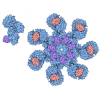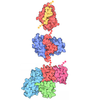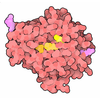+ Open data
Open data
- Basic information
Basic information
| Entry | Database: PDB / ID: 8aza | ||||||
|---|---|---|---|---|---|---|---|
| Title | Structure of RIP2K dimer bound to the XIAP BIR2 domain | ||||||
 Components Components |
| ||||||
 Keywords Keywords | IMMUNE SYSTEM / kinase / BIR2 / complex / dimer | ||||||
| Function / homology |  Function and homology information Function and homology informationresponse to interleukin-18 / toll-like receptor 2 signaling pathway / positive regulation of T-helper 1 cell differentiation / regulation of apoptosis involved in tissue homeostasis / positive regulation of protein linear polyubiquitination / positive regulation of cytokine-mediated signaling pathway / copper ion homeostasis / immature T cell proliferation in thymus / regulation of BMP signaling pathway / positive regulation of T-helper 1 type immune response ...response to interleukin-18 / toll-like receptor 2 signaling pathway / positive regulation of T-helper 1 cell differentiation / regulation of apoptosis involved in tissue homeostasis / positive regulation of protein linear polyubiquitination / positive regulation of cytokine-mediated signaling pathway / copper ion homeostasis / immature T cell proliferation in thymus / regulation of BMP signaling pathway / positive regulation of T-helper 1 type immune response / positive regulation of xenophagy / caspase binding / xenophagy / LIM domain binding / positive regulation of protein K63-linked ubiquitination / regulation of nucleotide-binding domain, leucine rich repeat containing receptor signaling pathway / nucleotide-binding oligomerization domain containing 1 signaling pathway / cellular response to muramyl dipeptide / positive regulation of stress-activated MAPK cascade / CARD domain binding / positive regulation of immature T cell proliferation in thymus / CD4-positive, alpha-beta T cell proliferation / JUN kinase kinase kinase activity / cellular response to peptidoglycan / response to interleukin-12 / positive regulation of CD4-positive, alpha-beta T cell proliferation / nucleotide-binding oligomerization domain containing 2 signaling pathway / SMAC, XIAP-regulated apoptotic response / cysteine-type endopeptidase inhibitor activity involved in apoptotic process / Activation of caspases through apoptosome-mediated cleavage / Regulation of the apoptosome activity / SMAC (DIABLO) binds to IAPs / SMAC(DIABLO)-mediated dissociation of IAP:caspase complexes / TNFR1-induced proapoptotic signaling / positive regulation of macrophage cytokine production / positive regulation of peptidyl-tyrosine phosphorylation / RIPK1-mediated regulated necrosis / toll-like receptor 4 signaling pathway / regulation of innate immune response / response to exogenous dsRNA / cellular response to lipoteichoic acid / positive regulation of interferon-alpha production / protein K63-linked ubiquitination / cysteine-type endopeptidase inhibitor activity / positive regulation of type I interferon production / negative regulation of tumor necrosis factor-mediated signaling pathway / canonical NF-kappaB signal transduction / stress-activated MAPK cascade / positive regulation of chemokine production / JNK cascade / signaling adaptor activity / ERK1 and ERK2 cascade / positive regulation of interleukin-12 production / positive regulation of interleukin-2 production / p75NTR recruits signalling complexes / response to interleukin-1 / protein serine/threonine kinase binding / positive regulation of interferon-beta production / Regulation of PTEN localization / lipopolysaccharide-mediated signaling pathway / JNK (c-Jun kinases) phosphorylation and activation mediated by activated human TAK1 / positive regulation of interleukin-1 beta production / positive regulation of protein ubiquitination / TNFR1-induced NF-kappa-B signaling pathway / activated TAK1 mediates p38 MAPK activation / non-membrane spanning protein tyrosine kinase activity / positive regulation of JNK cascade / Deactivation of the beta-catenin transactivating complex / non-specific protein-tyrosine kinase / Regulation of TNFR1 signaling / NOD1/2 Signaling Pathway / TAK1-dependent IKK and NF-kappa-B activation / protein homooligomerization / RING-type E3 ubiquitin transferase / Regulation of necroptotic cell death / positive regulation of interleukin-6 production / Regulation of PTEN stability and activity / Wnt signaling pathway / positive regulation of type II interferon production / Interleukin-1 signaling / cytokine-mediated signaling pathway / ubiquitin-protein transferase activity / positive regulation of tumor necrosis factor production / ubiquitin protein ligase activity / Ovarian tumor domain proteases / positive regulation of canonical Wnt signaling pathway / Downstream TCR signaling / T cell receptor signaling pathway / regulation of inflammatory response / neuron apoptotic process / response to lipopolysaccharide / regulation of apoptotic process / vesicle / adaptive immune response / cytoskeleton / positive regulation of ERK1 and ERK2 cascade / positive regulation of canonical NF-kappaB signal transduction / non-specific serine/threonine protein kinase / regulation of cell cycle / defense response to Gram-positive bacterium Similarity search - Function | ||||||
| Biological species |  Homo sapiens (human) Homo sapiens (human) | ||||||
| Method | ELECTRON MICROSCOPY / single particle reconstruction / cryo EM / Resolution: 3.15 Å | ||||||
 Authors Authors | Pellegrini, E. / Cusack, S. | ||||||
| Funding support | 1items
| ||||||
 Citation Citation |  Journal: Life Sci Alliance / Year: 2023 Journal: Life Sci Alliance / Year: 2023Title: Structure shows that the BIR2 domain of E3 ligase XIAP binds across the RIPK2 kinase dimer interface. Authors: Mathilde Lethier / Karine Huard / Michael Hons / Adrien Favier / Bernhard Brutscher / Elisabetta Boeri Erba / Derek W Abbott / Stephen Cusack / Erika Pellegrini /   Abstract: RIPK2 is an essential adaptor for NOD signalling and its kinase domain is a drug target for NOD-related diseases, such as inflammatory bowel disease. However, recent work indicates that the ...RIPK2 is an essential adaptor for NOD signalling and its kinase domain is a drug target for NOD-related diseases, such as inflammatory bowel disease. However, recent work indicates that the phosphorylation activity of RIPK2 is dispensable for signalling and that inhibitors of both RIPK2 activity and RIPK2 ubiquitination prevent the essential interaction between RIPK2 and the BIR2 domain of XIAP, the key RIPK2 ubiquitin E3 ligase. Moreover, XIAP BIR2 antagonists also block this interaction. To reveal the molecular mechanisms involved, we combined native mass spectrometry, NMR, and cryo-electron microscopy to determine the structure of the RIPK2 kinase BIR2 domain complex and validated the interface with in cellulo assays. The structure shows that BIR2 binds across the RIPK2 kinase antiparallel dimer and provides an explanation for both inhibitory mechanisms. It also highlights why phosphorylation of the kinase activation loop is dispensable for signalling while revealing the structural role of RIPK2-K209 residue in the RIPK2-XIAP BIR2 interaction. Our results clarify the features of the RIPK2 conformation essential for its role as a scaffold protein for ubiquitination. | ||||||
| History |
|
- Structure visualization
Structure visualization
| Structure viewer | Molecule:  Molmil Molmil Jmol/JSmol Jmol/JSmol |
|---|
- Downloads & links
Downloads & links
- Download
Download
| PDBx/mmCIF format |  8aza.cif.gz 8aza.cif.gz | 135.6 KB | Display |  PDBx/mmCIF format PDBx/mmCIF format |
|---|---|---|---|---|
| PDB format |  pdb8aza.ent.gz pdb8aza.ent.gz | 103.2 KB | Display |  PDB format PDB format |
| PDBx/mmJSON format |  8aza.json.gz 8aza.json.gz | Tree view |  PDBx/mmJSON format PDBx/mmJSON format | |
| Others |  Other downloads Other downloads |
-Validation report
| Summary document |  8aza_validation.pdf.gz 8aza_validation.pdf.gz | 1 MB | Display |  wwPDB validaton report wwPDB validaton report |
|---|---|---|---|---|
| Full document |  8aza_full_validation.pdf.gz 8aza_full_validation.pdf.gz | 1 MB | Display | |
| Data in XML |  8aza_validation.xml.gz 8aza_validation.xml.gz | 37.5 KB | Display | |
| Data in CIF |  8aza_validation.cif.gz 8aza_validation.cif.gz | 53.1 KB | Display | |
| Arichive directory |  https://data.pdbj.org/pub/pdb/validation_reports/az/8aza https://data.pdbj.org/pub/pdb/validation_reports/az/8aza ftp://data.pdbj.org/pub/pdb/validation_reports/az/8aza ftp://data.pdbj.org/pub/pdb/validation_reports/az/8aza | HTTPS FTP |
-Related structure data
| Related structure data |  15757MC M: map data used to model this data C: citing same article ( |
|---|---|
| Similar structure data | Similarity search - Function & homology  F&H Search F&H Search |
| Other databases |
- Links
Links
- Assembly
Assembly
| Deposited unit | 
|
|---|---|
| 1 |
|
- Components
Components
| #1: Protein | Mass: 10229.517 Da / Num. of mol.: 1 Source method: isolated from a genetically manipulated source Source: (gene. exp.)  Homo sapiens (human) / Gene: XIAP, API3, BIRC4, IAP3 / Production host: Homo sapiens (human) / Gene: XIAP, API3, BIRC4, IAP3 / Production host:  References: UniProt: P98170, RING-type E3 ubiquitin transferase | ||||
|---|---|---|---|---|---|
| #2: Protein | Mass: 36412.879 Da / Num. of mol.: 2 Source method: isolated from a genetically manipulated source Source: (gene. exp.)  Homo sapiens (human) / Gene: RIPK2, CARDIAK, RICK, RIP2, UNQ277/PRO314/PRO34092 / Production host: Homo sapiens (human) / Gene: RIPK2, CARDIAK, RICK, RIP2, UNQ277/PRO314/PRO34092 / Production host:  References: UniProt: O43353, non-specific serine/threonine protein kinase, non-specific protein-tyrosine kinase #3: Chemical | ChemComp-ZN / | Has ligand of interest | Y | |
-Experimental details
-Experiment
| Experiment | Method: ELECTRON MICROSCOPY |
|---|---|
| EM experiment | Aggregation state: PARTICLE / 3D reconstruction method: single particle reconstruction |
- Sample preparation
Sample preparation
| Component |
| ||||||||||||||||||||||||
|---|---|---|---|---|---|---|---|---|---|---|---|---|---|---|---|---|---|---|---|---|---|---|---|---|---|
| Source (natural) |
| ||||||||||||||||||||||||
| Source (recombinant) |
| ||||||||||||||||||||||||
| Buffer solution | pH: 7.5 | ||||||||||||||||||||||||
| Specimen | Embedding applied: NO / Shadowing applied: NO / Staining applied: NO / Vitrification applied: YES | ||||||||||||||||||||||||
| Vitrification | Cryogen name: ETHANE |
- Electron microscopy imaging
Electron microscopy imaging
| Experimental equipment |  Model: Titan Krios / Image courtesy: FEI Company |
|---|---|
| Microscopy | Model: FEI TITAN KRIOS |
| Electron gun | Electron source:  FIELD EMISSION GUN / Accelerating voltage: 300 kV / Illumination mode: OTHER FIELD EMISSION GUN / Accelerating voltage: 300 kV / Illumination mode: OTHER |
| Electron lens | Mode: BRIGHT FIELD / Nominal magnification: 165000 X / Nominal defocus max: 2500 nm / Nominal defocus min: 800 nm |
| Image recording | Electron dose: 46.7 e/Å2 / Film or detector model: GATAN K2 QUANTUM (4k x 4k) |
- Processing
Processing
| Software | Name: PHENIX / Version: 1.20.1_4487: / Classification: refinement | ||||||||||||||||||||||||||||
|---|---|---|---|---|---|---|---|---|---|---|---|---|---|---|---|---|---|---|---|---|---|---|---|---|---|---|---|---|---|
| EM software |
| ||||||||||||||||||||||||||||
| CTF correction | Type: PHASE FLIPPING AND AMPLITUDE CORRECTION | ||||||||||||||||||||||||||||
| 3D reconstruction | Resolution: 3.15 Å / Resolution method: FSC 0.143 CUT-OFF / Num. of particles: 173600 / Symmetry type: POINT | ||||||||||||||||||||||||||||
| Atomic model building | Protocol: RIGID BODY FIT / Space: REAL | ||||||||||||||||||||||||||||
| Refine LS restraints |
|
 Movie
Movie Controller
Controller



 PDBj
PDBj










